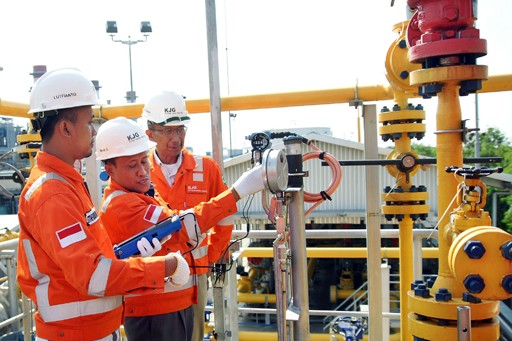Popular Reads
Top Results
Can't find what you're looking for?
View all search resultsPopular Reads
Top Results
Can't find what you're looking for?
View all search resultsGas integral to transition to clean energy: Gas industry
Change text size
Gift Premium Articles
to Anyone
G
as industry players believe the country’s transition toward clean energy is dependent on gas' contribution to the energy mix.
The intermittent nature and high cost of renewable energy are considered two major hurdles to phasing out fossil fuels.
Hazli Sham Kassim, the International Gas Union (IGU) regional coordinator for South and Southeast Asia, said gas was the best option for this transition because of its abundant reserves globally.
“They [renewable energy advocates] need us [gas industry] though they think otherwise. For example, some forms of renewable power can only transmit electricity during daylight, so you need gas to cover the rest,” he said.
He made the statement during his speech at the ninth IndoGas conference in Central Jakarta recently.
According to International Energy Agency (IEA) data, proven global gas reserves in 2016 totaled 215 trillion cubic meters (tcm), enough for 60 years with a production rate of 3 billion m3 (bcm).
This was similar to the supply of oil, according to UK-based energy giant BP's Statistical Review of World Energy 2016. The review states that globally there is a roughly 50-year supply of both oil and natural gas remaining.
Hazli of IGU, who is also general manager of Malaysian energy firm Petronas Indonesia, said natural gas was also better for the environment than “dirty” energy sources, such as coal and crude oil.
“Gas-fueled power plants emit about half the carbon dioxide [CO2] of coal-fired power plants,” he said, adding that renewable energy technology was still being developed.
The growing movement against “dirty” energy will see an increase in the use of natural gas globally, with the annual gas demand predicted to grow by 1.6 percent until 2040, becoming the second largest source of energy globally, according to the IGU.
By 2040, Southeast Asia’s energy demand will grow by almost 60 percent, equal to 10 percent of the global increase in demand. The supply of gas-fueled electricity is predicted to grow by 60 percent, but the share of gas in the power mix is predicted to shrink from 43 percent to 28 percent in the same period.
Upstream Oil and Gas Regulatory Task Force (SKK Migas) chairman Dwi Soetjipto said the energy industry should gradually switch its focus from oil to gas.
“[We] need to switch from oil to gas, we need to look at the cheaper energy and potential that natural gas can provide,” he said.
BP’s Statistical Review of World Energy 2018 shows that Indonesia’s proven gas reserves total 102.9 trillion cubic feet (tcf). This is 1.5 percent of total global gas reserves and the sixth highest in the Asia Pacific region.
However, Dwi said Indonesia’s gas reserves would not be sufficient to meet the increasing demand, meaning it was crucial to develop mega gas projects, such as the Masela Block in Maluku and the Indonesia Deepwater Development (IDD) in Makassar Strait, which if combined, could have a peak production of 994 million standard cubic feet per day.
“Those are efforts to maintain the current production [of oil and gas], but at the same time we need to find alternative [energy sources], such as renewable energy,” he said.
In two of the three scenarios reviewed by the Energy and Mineral Resources Ministry, the country is predicted to have a shortage of gas by 2025.
According to the National Energy Plan (RUEN), gas and renewable energy are predicted to form the backbone of the country’s energy mix by 2050, contributing 24 and 31 percent, respectively. Meanwhile, the contribution of oil is expected to drop from 46.6 percent to only 20 percent by 2050.










